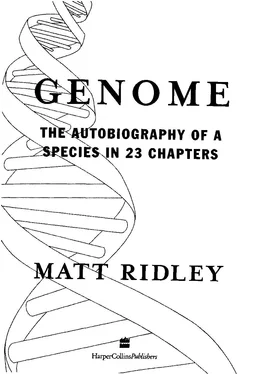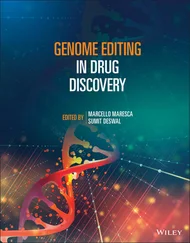Genome - Matt Ridley
Здесь есть возможность читать онлайн «Genome - Matt Ridley» — ознакомительный отрывок электронной книги совершенно бесплатно, а после прочтения отрывка купить полную версию. В некоторых случаях можно слушать аудио, скачать через торрент в формате fb2 и присутствует краткое содержание. Жанр: Старинная литература, на английском языке. Описание произведения, (предисловие) а так же отзывы посетителей доступны на портале библиотеки ЛибКат.
- Название:Matt Ridley
- Автор:
- Жанр:
- Год:неизвестен
- ISBN:нет данных
- Рейтинг книги:5 / 5. Голосов: 1
-
Избранное:Добавить в избранное
- Отзывы:
-
Ваша оценка:
- 100
- 1
- 2
- 3
- 4
- 5
Matt Ridley: краткое содержание, описание и аннотация
Предлагаем к чтению аннотацию, описание, краткое содержание или предисловие (зависит от того, что написал сам автор книги «Matt Ridley»). Если вы не нашли необходимую информацию о книге — напишите в комментариях, мы постараемся отыскать её.
Matt Ridley — читать онлайн ознакомительный отрывок
Ниже представлен текст книги, разбитый по страницам. Система сохранения места последней прочитанной страницы, позволяет с удобством читать онлайн бесплатно книгу «Matt Ridley», без необходимости каждый раз заново искать на чём Вы остановились. Поставьте закладку, и сможете в любой момент перейти на страницу, на которой закончили чтение.
Интервал:
Закладка:
At their birth, new technologies often seem hopelessly uncompetitive. The first railways were far more expensive than the existing canals and far less reliable. Only gradually and with time does the new invention bring down its own costs or raise its efficacy to the point where it can match the old. So it was with gene therapy.
Protein therapy had won the race to cure S C I D , but it required painful monthly injections into the hip, it was expensive and it needed to continue for life. If gene therapy could be made to work, it would replace all that with a single treatment that re-equipped the body with the gene it should have had in the first place.
In September 1990, Anderson and Blaese got the go-ahead and treated Ashanthi DeSilva, a three-year-old girl, with genetically engineered ADA. It was an immediate success. Her white-cell count trebled, her immunoglobulin counts soared and she began making almost a quarter of the A D A that an average person makes. The gene therapy could not be said to have cured her, because she was already receiving and continued to receive P E G - A D A . But gene therapy had worked. Today more than one in four of all known 2 5 0 G E N O M E
S C I D children in the world have had gene therapy. None are definitively cured enough to be weaned off P E G - A D A , but the side-effects have been few.
Other conditions will soon join S C I D on the list of disorders that have been tackled by retroviral gene therapy, including familial hypercholesterolaemia, haemophilia and cystic fibrosis. But it is cancer that is undoubtedly the main target. In 1992 Kenneth Culver tried an audacious experiment that involved the first direct injection of gene-equipped retroviruses into the human body (as opposed to infection of cultured cells outside the body and transfusion of those cells back in). He injected retroviruses directly into brain tumours of twenty people. Injecting anything into the brain sounds horrifying enough, let alone a retrovirus. But wait till you hear what was in the retrovirus. Each one was equipped with a gene taken from a herpes virus. The tumour cells took up the retrovirus and expressed the herpes gene. But by then the cunning Dr Culver was treating the patient with drugs for herpes; the drugs attacked the tumours.
It seemed to work on the first patient, but on four of the next five it failed.
These are early days in gene therapy. Some think it will one day be as routine as heart transplants are today. But it is too early to tell if gene therapy will be the strategy that defeats cancer, or whether some treatment based on blocking angiogenesis, telomerase or p53 wins that particular race. Whichever, never in history has cancer treatment looked so hopeful - thanks almost entirely to the new genetics.1
Somatic gene therapy of this kind is no longer very controversial.
Concerns about safety still remain, of course, but almost nobody can think of an ethical objection. It is just another form of therapy and nobody who has watched a friend or relative go through chemotherapy or radiotherapy for cancer would begrudge them, on far-fetched safety grounds, the comparatively painless possibility of gene therapy instead. The added genes go nowhere near the germ cells that will form the next generation; that worry has been firmly laid to rest. Yet germline gene therapy - changing genes in places where they would be passed on to future generations, which remains C U R E S 2 5 1
a total taboo in human beings - would in one sense be much, much easier to do. It is germline gene therapy, in the form of genetically modified soya beans and mice, that has caused a resurgence of protest in the 1990s. This is, to borrow a term from its detractors, Frankenstein technology.
The genetic engineering of plants took off rapidly for several reasons. The first was commercial: farmers have for many years provided an eager market for new seed varieties. In ancient pre-history, conventional breeding had turned wheat, rice and maize from wild grasses to productive crops entirely by manipulating their genes, though these early farmers did not of course know that this is what they were doing. In modern times, the same techniques have trebled yields and increased per-capita food production by more than twenty per cent even as world population doubled between 1960 and 1990. The 'green revolution' in tropical agriculture was largely a genetic phenomenon. Yet all this had been done blindly: how much more could be achieved by targeted, careful gene manipulation? The second reason for the genetic engineering of plants is the ease with which plants can be cloned or propagated. You cannot take a cutting from a mouse and grow a new mouse as you can from many plants. But the third reason was a lucky accident. A bacterium called Agrobacterium had already been discovered, which had the unusual property of infecting plants with small loops of D N A called Ti plasmids that incorporated themselves into plant chromosomes. Agrobacterium was a ready-made vector: simply add some genes to the plasmid, rub it on a leaf, wait for the infection to take hold and grow a new plant from the leaf cells. The plant would now pass on the new gene in its seeds. So in 1983, first a tobacco plant, then a petunia and then a cotton plant were genetically modified in this way.
The cereals, which are resistant to Agrobacterium infection, had to wait until the invention of a rather more crude method: the genes are literally shot into the cell on board tiny particles of gold using gunpowder or particle accelerators. This technique has now become standard for all plant genetic engineering. It has led to the creation 2 5 2 G E N O M E
of tomatoes less likely to rot on the shelf, cotton resistant to boll weevils, potatoes resistant to Colorado beetles, maize resistant to corn borers and many other genetically modified plants.
The plants progressed from laboratory to field trial to commercial sale with relatively few hiccoughs. Sometimes the experiments did not work - boll weevils devastated the supposedly resistant cotton crop in 1996 - and sometimes they attracted protest from environmentalists. But there was never an 'accident'. When the genetically modified crops were brought across the Atlantic, they encountered stronger environmental resistance. In Britain in particular, where food safety regulators had lost public confidence after the 'mad-cow'
epidemic, genetically modified food was suddenly a big issue in 1999, three years after it had become routine in the United States.
Moreover, in Europe Monsanto made the mistake of starting with crops rendered resistant to its own indiscriminate herbicide, Roundup. This enabled the farmer to use Roundup to kill weeds.
Such a combination of manipulating nature, encouraging use of herbicides and making profits infuriated many environmentalists.
Eco-terrorists began tearing up experimental plots of genetically manipulated oilseed crop and paraded around in Frankenstein suits.
The issue became one of Greenpeace's top three concerns, a sure sign of populism.
The media, as usual, rapidly polarised the debate with shouting matches between extremists on late-night television and interviews that forced people into simplistic answers: are you for or against genetic engineering? The issue reached its nadir when a scientist was forced to take early retirement over claims made in a hysterical television programme that he had proved that potatoes into which lectin genes had been inserted were bad for rats; he was later 'vindicated' by a group of colleagues assembled by Friends of the Earth.
The result proved less about the safety of genetic engineering than it did about the safety of lectins - known animal poisons. The medium had become confused with the message. Putting arsenic in a cauldron makes the stew poisonous, but it does not mean all cooking is dangerous.
Читать дальшеИнтервал:
Закладка:
Похожие книги на «Matt Ridley»
Представляем Вашему вниманию похожие книги на «Matt Ridley» списком для выбора. Мы отобрали схожую по названию и смыслу литературу в надежде предоставить читателям больше вариантов отыскать новые, интересные, ещё непрочитанные произведения.
Обсуждение, отзывы о книге «Matt Ridley» и просто собственные мнения читателей. Оставьте ваши комментарии, напишите, что Вы думаете о произведении, его смысле или главных героях. Укажите что конкретно понравилось, а что нет, и почему Вы так считаете.












